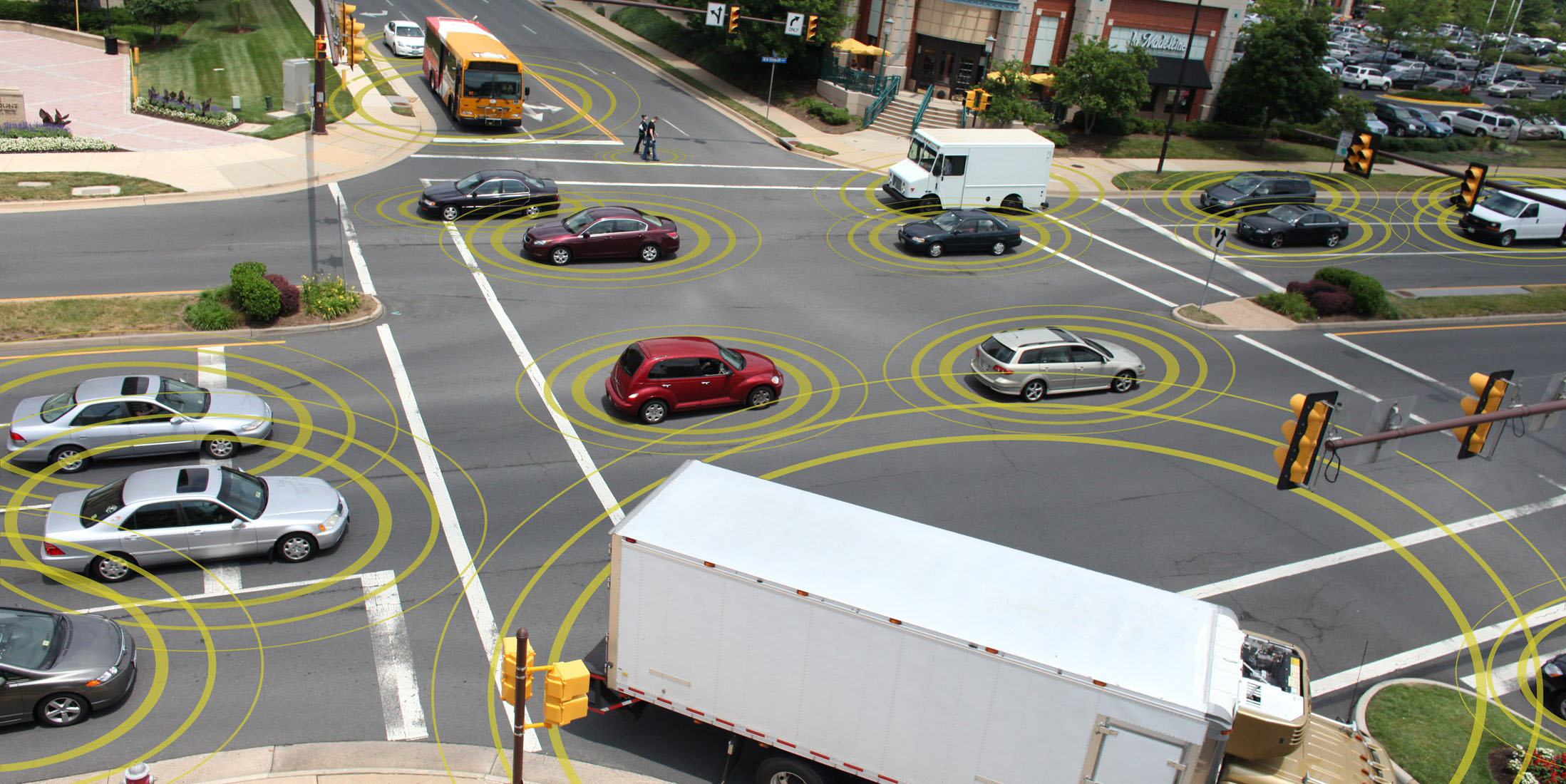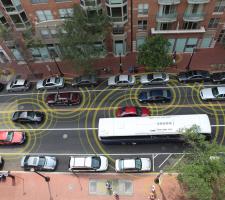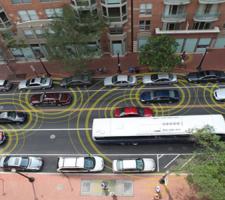
The forthcoming Model Deployment will test Connected Vehicle technology and applications with an appreciably larger fleet than has been used before (Picture: USDOT)
The use of frequency spectrum at 5.9GHz for vehicle safety applications is at risk because of two draft bills currently before Congress. Here, we look at why and what’s being done to address the issue
In the US, the right of cooperative infrastructure to use frequency at 5.9GHz is under threat as a result of the proposal of two bills in Congress.The chronology of spectrum allocation for Dedicated Short- Range Communications (DSRC)-based Vehicle-to-Infrastructure (V2I) and Vehicle-to-Vehicle (V2V) safety applications is wellknown; in 1999, following a petitioning effort started by
Although to those unfamiliar it might appear that little progress has been made since that date, in fact much has gone on. In many respects, the lack of an appearance of working cooperative infrastructures is unremarkable and a product of due process; standards for the cellular telephony industry took years to formulate, for instance.
In 2003, therefore, the FCC began work on the writing of the technical and service rules for DSRC. This was followed by the opening of licensing the following year. Since then, other work has gone on to allow spectrum sharing with the satellite industry (which operates a few uplink stations along the US’s east and west coast in remote areas, and alongside some scattered military systems) and now we have reached the point where the industry awaits DSRC standards being completed in IEEE standards.
These finalised standards will ultimately be incorporated into the FCC’s technical and service rules.
Testing applications
In the meantime, companies have developed DSRC systems using draft standards and have begun to experiment with V2I and V2V applications.The utility of DSRC has been tested in a series of projects, with standards and FCC rulemaking conducted in parallel. For example, the USDOT ran a proof of concept with DSRC roadside unit vendors in 2008 which proved the feasibility of the V2I elements of cooperative infrastructures. Meanwhile the Crash Avoidance Metrics Partnership (CAMP) vehicle safety communications consortium, which consists of eight major auto manufacturers plus the USDOT, has been proving out V2V applications.
The US’s cooperative infrastructure programme has existed under several names since its inception and has now settled on the name Connected Vehicle. Under the Connected Vehicle Safety Pilot programme, Driver Clinics to gauge public opinions of and reaction to V2V applications and technologies have been taking place since August this year. These Clinics have also been designed to assess drivers’ attitudes and styles across many geographical regions within the US and will be followed by a Model Deployment (see ‘Critical connections’, pp.NA5-NA6, ITS International, July-August 2011).
The Model Deployment is effectively a field operational trial and will, for the first time, use an appreciable fleet of vehicles; 3,000 is the figure given by USDOT. It has two purposes.
The first is to provide information which will support a potential rulemaking, beginning in 2013, by the National Highway Traffic Safety Administration (NHTSA) on whether to make V2V communications systems fitment on new-build vehicles standardised or mandatory (a potential rulemaking on commercial vehicles is due in 2014). The rulemaking process will require much data to support any agency decision. The Model Deployment will take place in a very stringent, data-intensive environment therefore and look at the possible effects of the rulemaking on industry, in terms of cost-effectiveness, and from the perspective of technological maturity.
The second is quite simply to see and prove whether DSRC is fit for purpose; in effect, the Model Deployment will set out to prove that the technologies which have spent so many years in development are scalable.
A notable departure for NHTSA in terms of DSRC is that previous rulemakings have dealt with technologies already in the marketplace such as seatbelts and electronic stability control (ESC) systems. This will be the first time that a new-to-the-market technology will be subject to a rulemaking and reflects the nature of DSRC and cooperative infrastructures; in order to be effective, they need large numbers of vehicles to be equipped within a very short space of time and this is one of the reasons why multiple routes to market (incorporation of DSRC-based communication systems into new-build vehicles, retrofit systems and aftermarket devices) are being explored.
In summary, then, the current challenge from the purely technical perspective is to take a large number of pieces of elements which work (frequency spectrum, standards equipment and applications) and meld them into a whole; having components doesn’t necessarily mean that a wide-scale working system can be rolled out tomorrow and so the Safety Pilot and Model Deployment can be neatly described as a de-risking exercise.
Legislative risks
The fly in the ointment comes about as a result of draft legislation which has been placed in front of Congress. Like many countries around the world, the US is looking at measures to correct significant budget deficits and one area which has come under scrutiny is radio frequency allocations. Two draft bills, propose either to allow unlicensed use of spectrum in the above- 5.0GHz bandwidth range or else allow the auctioning of frequency.This summer, Congresswoman Doris Matsui (Democrat, California) proposed that frequency bandwidth at 5.9GHz be opened to unlicensed users. Shortly thereafter, Congressman Greg Walden (Republican, Oregon), who chairs the House Energy and Commerce Committee’s Communications and Technology Subcommittee, proposed that the same bandwidth be put up for public auction.
In many respects, the two proposals reflect ideological differences, with the Democrats pursuing free unlicensed use and the Republicans preferring an auction, but the net effect would be the same: bandwidth at 5.9GHz would no longer be reserved exclusively for road safety-related DSRC applications.
The uninitiated might consider that with no live deployment of cooperative infrastructure since spectrum allocation in 1999, the 5.9GHz bandwidth was in any case at risk. As noted above, however, due process is in many respects the culprit rather than a lack of bravery or budgets. The original proposal by Matsui looks to be less about going after ‘unused’ DSRC spectrum and more about freeing up more lower 5.0GHz swath for WiFi applications and activities; 5.9GHz just happens to get caught up in a larger whole.
It should be noted that Matsui’s proposal included a very loosely worded declaration that there would be no interference with current licensed users (such as DSRC), and that the FCC would determine if technical solutions such as spectrum-sharing technologies could be employed Furthermore, the Matsui bill requires a Department of Commerce study to determine the impact of new unlicensed technologies to 5.9GHz incumbents.
The bill regrettably only requires the study to evaluate risks to Federal users, such as the military, with no requirement to investigate the effects on others such as state road operators, local fire, police, ambulance services, or the everyday driver who may rely on DSRC to keep them safe from potential harm.
House Energy and Commerce Chairman Walden’s proposal, by contrast, identifies specific bandwidths for auction, including 5.3GHz and 5.9GHz, and also includes unlicensed use but the overall language of his proposal is less clear. If what Chairman Walden has suggested goes ahead, however, it would be unprecedented that such a high frequency band would have ever been auctioned before. Typically, that which has come up for auction in the past has been spectrum below 2.0GHz, which is suitable for much longer-range communications and is highly prized by the cellular industry The 5.0GHz band is suited to very short-range communications (typically, 100-1000m), which is one reason why it was chosen for proximate vehicle-related safety applications in the first place. It would be expensive and unsuitable for use, for example, by the cellular industry as the basis of a long-range communications network as it would need a large, costly infrastructure of closely spaced communications nodes meshed together. The Congressional Budget Office would need to score any such auction according to its perceived value at auction and ITS industry observers doubt that an auction of frequency in the greater than 5.0GHz band would realise any meaningful sum for the government’s depleted coffers.
Raising awareness
ITS America has been working to raise awareness of the issues at hand. It has sent letters to Chairman Walden and Congresswoman Anna Eshoo (Democrat, California), who serves as her party’s ranking official on the Energy and Commerce Subcommittee, as well as Matsui. These express concern and opposition to the opening up to unlicensed use or auctioning of spectrum without further investigation. In particular, ITS America makes the point that with deployment of vehicle-related safety systems so close it makes little sense to shift the goalposts. The AAA, Alliance of Automobile Manufacturers, Association of Global Automakers and other industry associations and public safety advocacy organisationsare all signatories, and similar concerns have also beenexpressed in written form by the American Association of State Highway and Transportation Officials.As well as explaining to Committee staffers just what the issues are, ITS America has been meeting with parties in favour of opening up frequency spectrum with the aim of reaching consensus on how to ensure that 5.9GHz is not compromised.
There is reportedly a sense that many of those in Washington had little or no idea that the frequency spectrum being proposed for unlicensed use or auction was already allocated to vehicle/infrastructure DSRC.
Thus far, there is agreement that all parties should look to move forwards in a way which accommodates DSRC for Connected Vehicle applications.
From the transportation industry side, there is a belief that the burden of proof has to lie with the newcomer organisations and stakeholders rather than the incumbents







